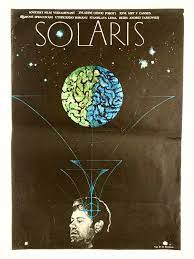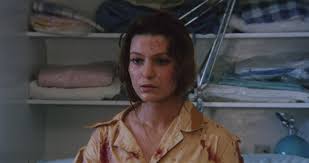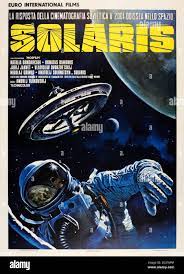Solaris (1972)
IMDb meta-data is Hollywood runtime of 2 hours and 47 minutes, rated an astounding 8.0 by 92,000 victims of the Stockholm syndrome.
Genre: Sy Fy; Species: Endurance.
Verdict: Ho hum.
Tag line: Are we there yet?

The prolific Pole Stanislaw Lem wrote the novel (which I have read more than once, I seem to recall) but this production is from the USSR. It seems largely faithful to the novel apart from wisely cutting all the background about Solaristics, i.e., the study of the watery planet called Solaris somewhere off in deep space. (In the novel this ‘ology’ allows Lem much sardonic commentary for many pages on the ways of academics which is mildly amusing but turgid.)
Things are bad on the research space station in orbit around Solaris, very bad. Most of the crew of eighty have decamped and clammed up about why. Well, I guess, though that and much else is not made clear. There remain three persons on board: Snaut, Sartorius, and Gribarayn. However, we first meet Pilot Berton testifying to an inquiry into the earlier death of one of the researchers scouting the planet. It is a superb performance that adds nothing to the film…. Well, there is an echo of it at the end, but very faint.
The planet is a single, roiling ocean and there is some nice footage of its currents and tides. If they are studying it, [spoiler ahead] it seems the ocean is also studying them. It does so by producing from their memories the most vivid person in their past. This selection is made clear in the book, the most vivid memory, but not in the film. This drives the crew members nuts for some reason.
Pop quiz! Who would that be in your memory? Answers below.
To deal with the problem a psychologist comes to investigate and report. He arrives – poof – to find the station in rack and ruin. No one has swept the floor in a long time. It looks like the frat house. Nor does anyone greet him. Turns out his old buddy Gribarayn who evidently owed him money has committed suicide rather than wait for him and pay up but he has left an incomprehensible video of warning to get even.

In no time at all Psychologist’s dead wife is holding his hand and he accepts this far too quickly and easily. Yes, I know the first time he tries to dispatch her, but he never seems shocked, surprised, revolted, repulsed, repelled, or disturbed by this simulacrum usurping and desecrating his deceased wife. He wanders around the derelict station for about three hours with her – the end. The sleeper awoke, or did he?
A wonderful special effects scene occurs when the station’s orbit is adjusted for 30 seconds and 0 g follows, but it adds nothing to either character or plot. Well, it could not add to the plot since there is not one there to begin with. And the psychologist, despite all the screen time and accolades from critics, never comes alive to this viewer.
It is has some of the qualities of post-modern philosophy. The narrative is oblique, reflexive, unreliable, disjointed, and pointless. Trying to understand it is the mistake. It is another turkey from Tartovsky, Andrei whose contempt for the audience is palpable. The more he reviles the viewers and reviewers, the more they laud him in a Stockholm Syndrome. Even that doyen Roger Ebert succumbed to this abusive treatment and praises the film to the skies. I re-read his essay on this film after I watched it on You Tube. Intransigent I remain.
Yes, I know it is supposed to be a mediation on reality and identity with the ghostly wife, on what it means to exist for her, on what we love in another person, what they are, or what we think they are, and so on; and also how would we react to an alien intelligence so different from our own as to be unintelligible. But little, if any, of that is conveyed in this montage. That is all post hoc intellectual justification for sitting through this three hour film.

I saw this version at the Sydney Film Fesitval shortly after I got to Australia, and found it as unpalatable then, as I do now. In comparison, Last Year at Marienbad is fast moving and exciting, ahh… [thinks of Delphine Seyrig] with eye candy. However, seeing Solaris the first time introduced me to Stanislaw Lem and I read a number of his novels later. When I noticed that the local Dendy was screening a 35 millimetre print on Wednesday night I was tempted, but upon remembering that runtime decided I would settle for the You Tube version because I could sit in the recliner, shoes off, with a glass in hand and tap out caustic comments on the iPad, stopping and starting as needed. Watching it for three hours in a chilled theatre unable to move was out of the question.
One mystery is how a committee of comrades invested in this film in the first place in the early 1970s. What did they think they were getting? Better, what did they think of what they got?
By the way, there are at least three films based on this Lem novel. There is an earlier one made for Soviet television in black and white (1968) of 2 and 1/2 hours (available on You Tube) and the American remake of 2002 which is a merciful 95 minutes. Take your pick.
P.S. At least I could tell what Last Year at Marienbad (1961) was about, even if it was boring. The characters all have rich and luxurious but empty lives, so empty that there is nothing worth doing, still less remembering and certainly not love or sex. It was a common theme in post war Western European movies about the vacuous idle rich. Without the evil Nazis to contend with, there was nothing to do but self-indulgence. See a host of especially Italian movies like L’Avventura (1960). This nihilist self indulgent ennui was one response to the absurdity of life. Another response was to commit to the cause de jour vide Sartre. A third was to take up golf.

